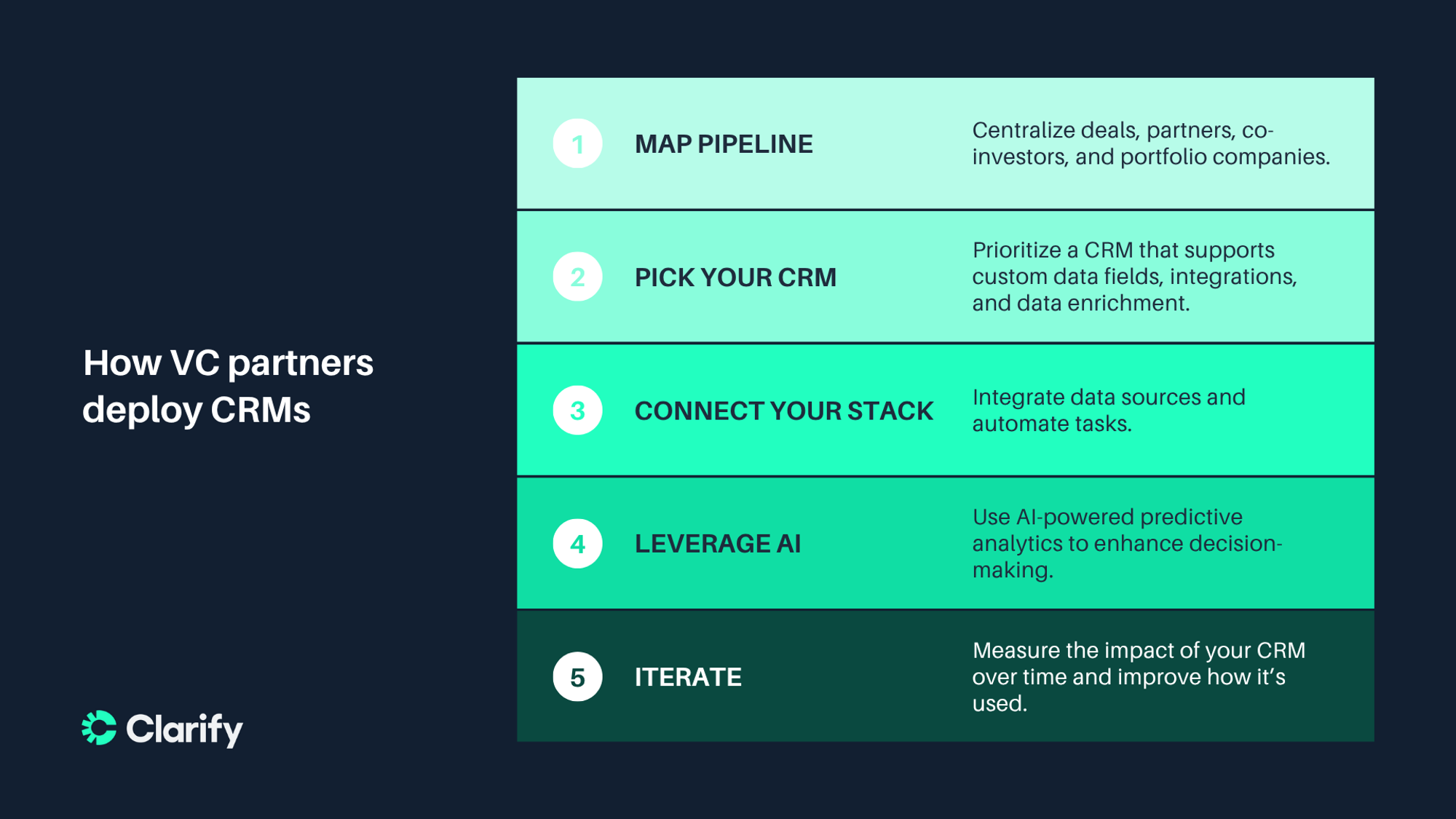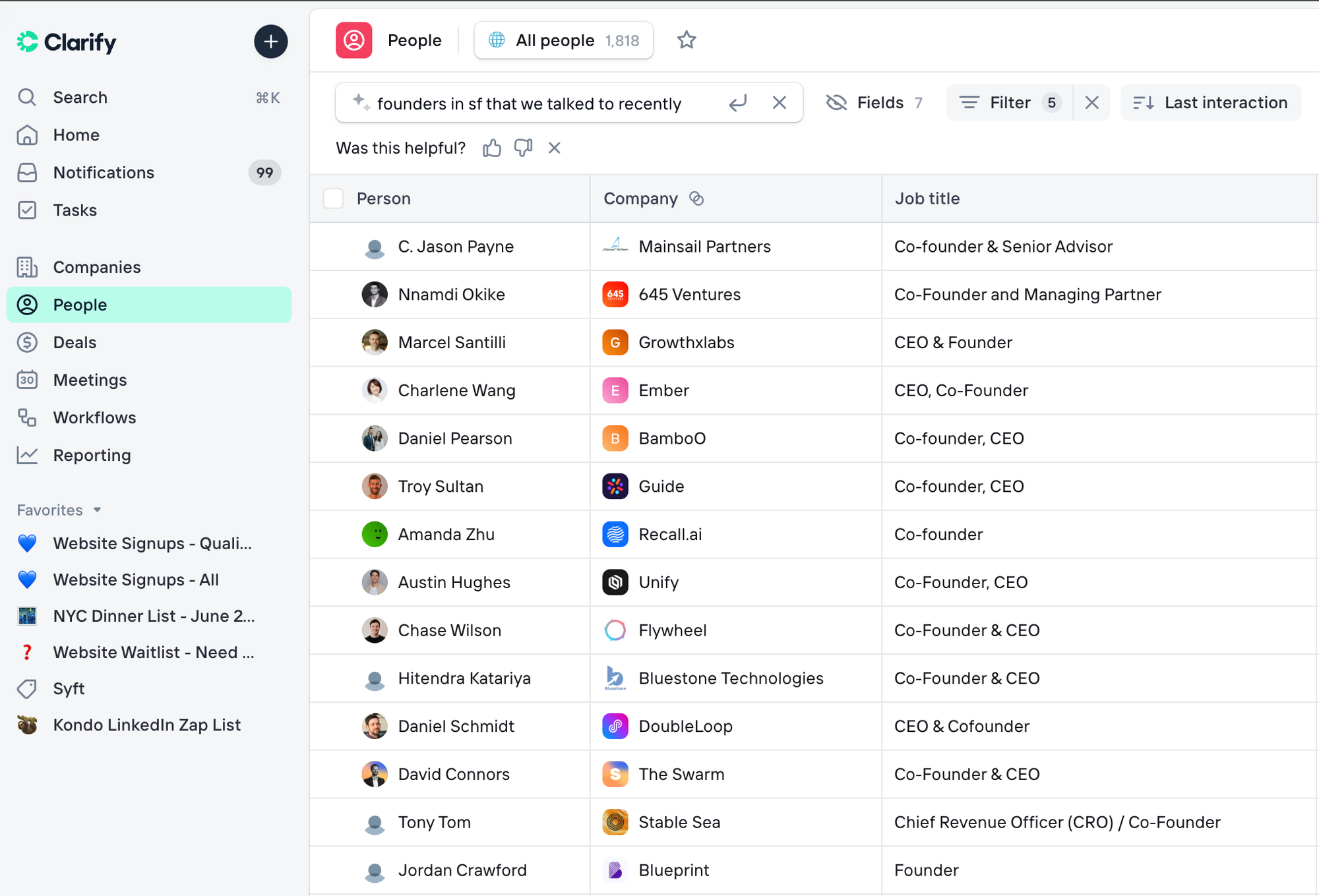How VC partners can better manage deals with an AI-powered CRM

When only 10-15% of venture capital deals are responsible for the majority of a firm’s returns, you don’t want a single deal falling through the cracks.
But for too many funds, relationships are nurtured in text messages and emails. Deals are tracked in spreadsheets. Entire portfolios are managed with manual data entry and fragmented databases.
A CRM takes scattered data and tasks and puts them all in one place, giving you everything you need to build stronger relationships with partners and founders. That said, traditional CRMs are rarely robust enough for VC partners.
That’s why an AI-powered, autonomous CRM like Clarify can help you make the shift you need to never miss a killer deal. Here’s a step-by-step guide for deploying your own.

Step 1: Map your VC deal pipeline and relationship data
A single, unified view of potential deals, partners, co-investors, and portfolio companies is essential for better decision-making. Without this perspective, you’ll waste time rebuilding context for deals from text messages and email chains, miss warm introductions, and duplicate outreach efforts.
Clarify puts AI at your fingertips so you can unify data into a single, coherent view, using relationship intelligence to better sift through potential founders and deals.

Natural language AI search helps you filter contacts easily.
Relationship intelligence aggregates insights about connections, introductions, and interactions, helping you chart a path towards the right decision on every deal. But this only works if you do a bit of prep work in mapping out your deal pipeline.
Your deal pipeline should encompass the full VC journey, from sourcing to due diligence, and investment to post-investment. Note down the data fields you’ll need in your CRM along this pipeline:
- Deal size and stage
- Sector and sub-vertical focus
- Lead investor and syndicate composition
- LP interest level and commitment timeline
- Founder background and previous exits
- Competitive landscape and differentiation
- Board composition and advisor network
Knowing where this data currently lives, how it’s collected, and how it needs to be cleaned before you start using a CRM is essential to working with that data later on.
Benchmark your current pipeline visibility by estimating the percentage of deals with complete information for the fields above. You can measure this again after deploying your CRM to get a sense of its impact.
Step 2: Pick an AI-powered CRM for VC-specific workflows
Choosing the right CRM can involve some trial and error, but you can avoid that lengthy process by evaluating them according to criteria specific to VC needs, such as:
- Custom data fields for metrics that matter, whether that’s financials like gross margin or business health like customer churn.
- Integrations and automations, so you can more effectively centralize important data without any extra manual work.
- Contact and deal management, allowing you to leverage relationship intelligence for better deals.
- Data enrichment, which automatically improves contacts and deals, saving you precious time.
- Event-driven architecture, which automatically updates deal records, alerts team members, and suggests follow-up actions when relevant triggers happen, such as an email from a specific CEO.
Compare these metrics across a handful of vendors, at least three to five, and you’ll get a sense of which one is most likely to meet your needs.
Step 3: Connect your stack and automate your tasks
One of the most important things to do when deploying your CRM is to integrate it with your existing stack. Tools like Gmail, Outlook, Slack, Zoom, and Calendly are essential to your pipeline and full of the data you need. Use your CRM’s built-in integrations where available, and consider third-party integrations if needed.
An autonomous CRM like Clarify does more than just automate pipeline-related tasks. It keeps data flowing across tools with minimum manual intervention.
Depending on the CRM you use, you might be able to automate the following:
- Auto-capture of inbound and outbound emails. Information from emails is extracted and added to relevant deal records.
- Sync calendar events to update pipeline stages when necessary meetings happen.
- Enrich contacts with real-time data pulled from your actions and publicly available information like funding history.
- Analyze meeting notes and call recordings for action items, sentiment analysis, and key decision points.
- Create follow-up tasks and similar activities based on pipeline stages.
The right CRM platform allows VC partners to spend more of their time on activities that lead to closed deals and better returns for their funds, and less on chasing emails and filling out spreadsheets.
Step 4: Use AI and predictive analytics for smarter deal prioritization
Predictive analytics allows you to turn existing data into future trends, enhancing your decision-making process. Doing this without the right technology involves heavy data collection and analysis, which many VCs don’t have time for. AI is an essential tool for predictive analytics, and an AI-powered CRM can apply this powerful methodology to your deal data.
A predictive analytics scoring model should combine the quantitative aspects of a potential investment (e.g., revenue growth rate, burn rate efficiency, market size) with qualitative factors like team experience and product-market fit. An AI model can then weigh these factors according to your firm’s investment thesis. A B2B SaaS-focused firm, for example, might prioritize recurring revenue while a deep-tech investor would emphasize patents and technical differentiation. The output of these models can lead to a more informed deal score that you can use to prioritize incoming deals.
Armed with this information, you can combine deal score with other prioritization metrics like:
- Key drivers behind a deal’s rank.
- Recent activity that influences the score.
- Recommended actions for advancing opportunities.
- Network connections for warm introductions.
Step 5: Iterate, scale, and optimize
Continuous improvement is key to anything your firm does, and the way you use your CRM is no different. Adopt key metrics to gauge the impact of your CRM, such as:
- Auto-capture rate.
- Data enrichment latency.
- Deal-scoring accuracy.
- Partner adoption rate.
- Integration uptime.
If you want to test the validity of an AI-powered CRM and its impact on your decision-making, run an A/B test comparing your CRM’s deal scores with the intuition of your firm’s partners. Track deals the AI surfaced that your partners missed, and vice versa. Over a long enough time horizon, you can identify which group is more accurate.
As you use your CRM for more and more workflows, explore opportunities for improvement. Maybe adding a new data source will give partners a more complete picture of each deal? Maybe you’ll find some automated processes aren’t quite cutting it? Maybe you’ll even need to find ways to improve adoption throughout your firm.
There is no doubt that a CRM will beat out spreadsheets and emails for managing your deal pipeline. The only question is how much of an impact it can have on your operations.
Frequently asked questions
How do I import existing deal data into a CRM?
If most of your data is still in spreadsheets, importing data is as simple as turning your spreadsheets into a CSV file. Most CRMs will have a built-in importer for these files. Some will even allow you to connect spreadsheets to your pipeline directly, automatically pulling data from them. Note that you’ll need to clean your data during this process, which involves removing duplicates, standardizing company names, and verifying contact information.
What’s the difference between an AI CRM like Clarify and ChatGPT?
ChatGPT is a general AI model, meaning it can answer any questions you have relatively well, but it’s more limited when it comes to VC-specific tasks. An AI CRM like Clarify homes in on the specific tasks involved in closing better deals, giving you more AI juice for the squeeze.
How can an AI CRM improve our deal flow?
An AI-powered CRM can automate the administrative tasks that come with VC deal flow, from sourcing leads to enriching contacts and scheduling follow-up tasks. This frees up partners and other contributors so they can dedicate more time to building their network and drilling down into the companies they want to invest in.
How can I ensure data security and compliance with an AI CRM?
Choose a vendor with enterprise-grade security like SOC 2 Type II certification, end-to-end encryption, and role-based access controls. You can also ask about internal processes like security audits, data retention policies, and security training.
What’s the best way to measure ROI after implementing an AI CRM?
You need quantifiable metrics, like time saved on manual data entry (hours per week per person), an increase in qualified deal flow (measured by conversion rates from initial contact to term sheet), or revenue uplift from better deal prioritization.
You can then calculate ROI by turning one or more of these metrics into a dollar value and doing the following calculation: (benefit of implementation - implementation cost) / implementation cost over 12 months = ROI.
Get our newsletter
Subscribe for weekly essays on GTM, RevTech, and Clarify’s latest updates.
Thanks for subscribing! We'll send only our best stuff. Your information will not be shared and you can unsubscribe at any time.